Top speed 515 km/h Wingspan 18 m Engine type Reciprocating engine | Length 13 m Introduced 27 July 1940 First flight July 17, 1939 | |
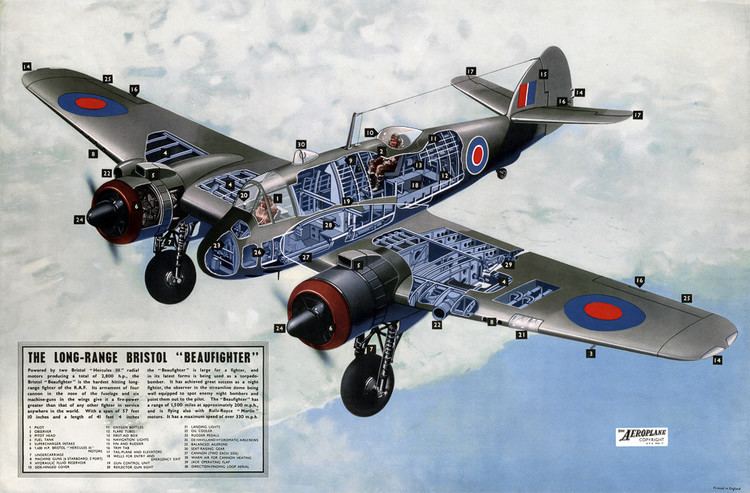 | ||
Manufacturers Tipsy, Bristol Aeroplane Company | ||
Bristol beaufighter ten gun terror
The Bristol Type 156 Beaufighter (often referred to simply as the "Beau") is a multi-role aircraft developed during the Second World War by the Bristol Aeroplane Company in the United Kingdom (UK). It was originally conceived as a heavy fighter variant of the Bristol Beaufort bomber. Upon its entry to service, the Beaufighter proved to be well suited to the night fighter role, for which the Royal Air Force (RAF) initially deployed the type as during the height of the Battle of Britain, in part due to its large size allowing it to accommodate both heavy armaments and early airborne interception radar without major performance penalties.
Contents
- Bristol beaufighter ten gun terror
- Origins
- Prototypes and refinement
- Production
- Design
- Introduction
- Coastal Command
- Pacific War
- Southwest Pacific
- Postwar
- Variants
- Museum display
- Under restorationstored
- Specifications Beaufighter TF X
- References
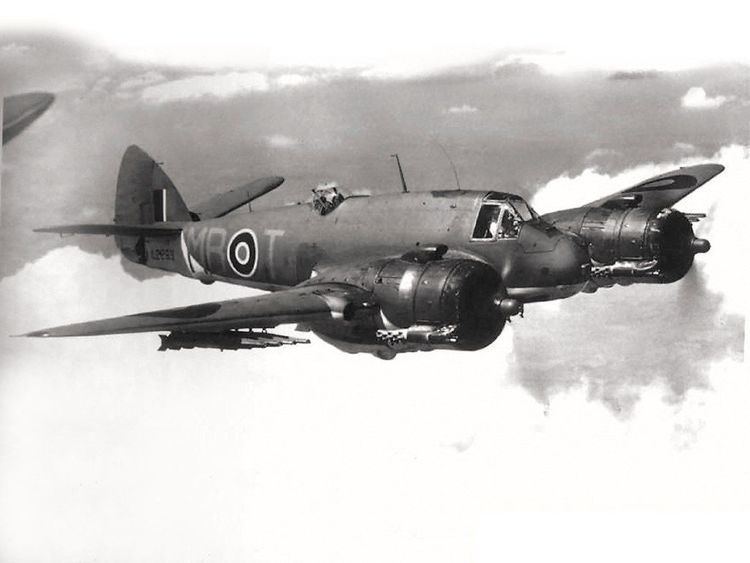
As its wartime service continued, the Beaufighter was applied to many different roles; receiving the monikers Rockbeau for its use as a rocket-armed ground attack aircraft, and Torbeau in its role as a torpedo bomber against Axis shipping, in which it came to replace the preceding Beaufort. In later operations, it served mainly as a maritime strike/ground attack aircraft, RAF Coastal Command having operated the largest number of Beaufighters amongst all other commands at one point. The Royal Australian Air Force (RAAF) also heavily used the type in the maritime anti-shipping role, such as during the Battle of the Bismarck Sea.
The Beaufighter saw extensive service during the war with the RAF (59 squadrons), Fleet Air Arm (15 squadrons), RAAF (seven squadrons), Royal Canadian Air Force (four squadrons), United States Army Air Forces (four squadrons), Royal New Zealand Air Force (two squadrons), South African Air Force (two squadrons) and Polskie Siły Powietrzne (Free Polish Air Force; one squadron). In addition, variants of the Beaufighter were also manufactured in Australia by the Department of Aircraft Production (DAP); such aircraft are sometimes referred to by the name DAP Beaufighter.
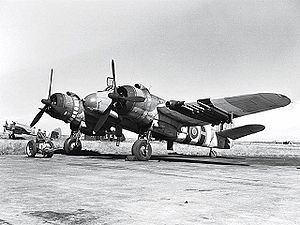
Origins
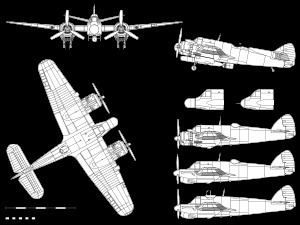
The concept of the Beaufighter has its origins in 1938. During the Munich Crisis, the Bristol Aeroplane Company recognised that the Royal Air Force (RAF) had an urgent need for a long-range fighter aircraft capable of carrying heavy payloads for dealing high amounts of damage. The results of evaluations of the Beaufort had concluded it to have great structural strength and stiffness in areas such as the wings, nacelles, undercarriage and tail, so that the aircraft could be readily developed further for greater speed and manoeuvrability akin to a fighter-class aircraft. Accordingly, Bristol's design team, led by L.G. Frise, commenced the development of a cannon-armed fighter derivative as a private venture. A key goal for the prospective aircraft was to share the same jigs as the in-production Beaufort so that manufacturing could be switched from one aircraft to the other at short notice.
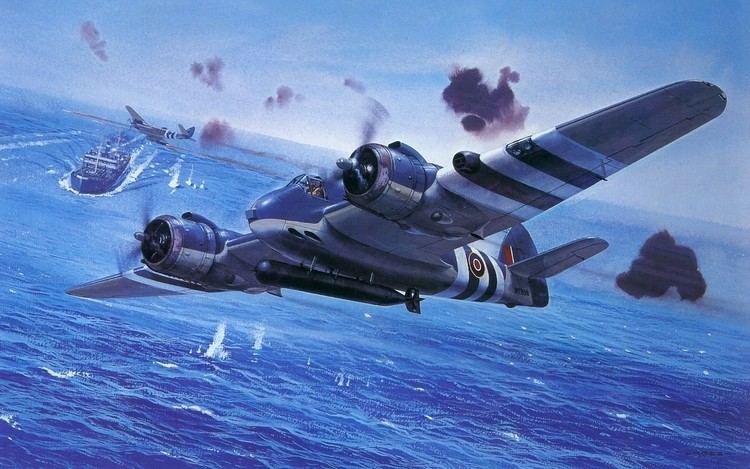
As a torpedo bomber and aerial reconnaissance aircraft, the Beaufort had moderate performance. However, to achieve the fighter-like performance desired for the Beaufighter, Bristol suggested that they equip the aircraft with a pair of their new Hercules engines, capable of around 1,500 hp, in place of the Beaufort's 1,000 hp Bristol Taurus engines. The Hercules was a considerably larger and more powerful engine, which required larger propellers. To obtain the necessary ground clearance, the engines were mounted centrally on the wing, as opposed to the underslung position on the Beaufort. In October 1938, the project, which received the internal designation Type 156, was outlined. In March 1939, the Type 156 was given the name Beaufighter.
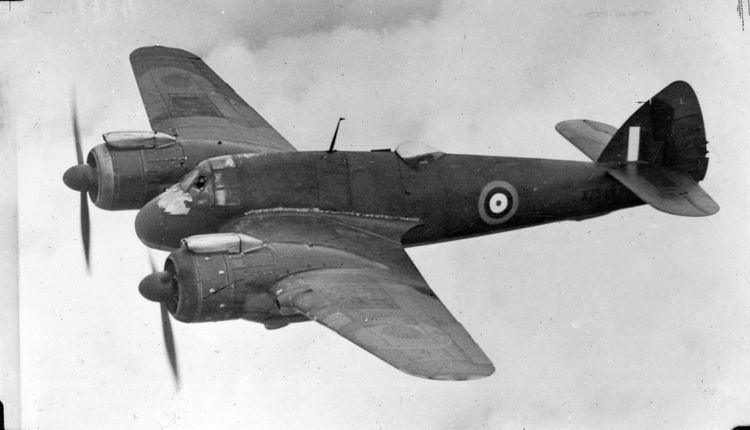
During early development, Bristol had formalised multiple configurations for the prospective aircraft, including variations such as a proposed three-seat bomber outfitted with a dorsal gun turret armed with a pair of cannons, designated as the Type 157, and what Bristol referred to as a sports model, which was equipped with a thinner fuselage, designated as the Type 158. Bristol proceeded to suggest their concept for a fighter development of the Beaufort to the Air Ministry. The timing of the suggestion happened to coincide with delays in the development and production of the Westland Whirlwind cannon-armed twin-engine fighter. While there was some scepticism that the aircraft was unnecessarily large for the fighter role, the proposal was given an overall warm reception by the Air Staff.
Accordingly, the Air Ministry produced draft Specification F.11/37 written around Bristol's suggestion for an "interim" aircraft, pending the proper introduction of the Whirlwind. On 16 November 1938, Bristol received formal authorisation to commence the detailed design phase of the project and to proceed with the construction of four prototypes. Amongst the design requirements was that the aircraft had to be able to accommodate the Rolls-Royce Griffon engine as an alternative powerplant to the proposed Hercules, and that it have maximum interchangeability between the two engines, which would feature removable installations.
Bristol began building an initial prototype by taking a partly built Beaufort out of the production line. This conversion served to speed progress; Bristol had promised series production in early 1940 on the basis of an order being placed in February 1939. Designers expected that maximum re-use of Beaufort components would speed the process, but the fuselage required more work than expected and had to be completely redesigned. Perhaps in anticipation of this, the Air Ministry had requested that Bristol investigate the prospects of a 'slim fuselage' configuration. Since the "Beaufort cannon fighter" was a conversion of an existing design, development and production was expected to proceed more quickly than with a completely fresh design. Within six months of the first F.11/37 prototype, designated R2052, had been completed. A total of 2,100 drawings were produced during the transition from Beaufort to the prototype Beaufighter, more than twice as many were created during later development, between the prototype Beaufighter and the fully operational production models. Two weeks prior to the prototype's first flight, an initial production contract for 300 aircraft under Specification F.11/37 was issued by the Air Ministry, effectively ordering the type directly "off the drawing board".
Prototypes and refinement
On 17 July 1939, R2052, the first prototype, conducted its maiden flight, a little more than eight months after development had formally started. In its initial configuration, R2052 was unarmed. The rapid pace of development achieved is partially attributable due to the re-use of many elements of the Beaufort's design along with frequently identical components. R2052 proceeded to be initially operated by Bristol for testing purposes while it was based at Filton Aerodrome. Early modifications to R2052 included stiffening of the elevator control circuit, the fin area increased, and lengthening of the main oleo strut of the undercarriage to better accommodate both future weight increases and hard landings.
During the pre-delivery trials, the first prototype R2052, powered by a pair of two-speed supercharged Hercules I-IS engines, had achieved 335 mph (539 km/h) at 16,800 ft (5,120 m) in a clean configuration. The second prototype, R2053, which was furnished with Hercules I-M engines (similar to Hercules II) and was laden with operational equipment, had attained a slower speed of 309 mph at 15,000 ft. According to aviation author Philip J.R. Moyes, the performance of the second prototype was considered to have been disappointing, particularly as the Hercules III engines of the initial production aircraft would likely provide little improvement, especially in light of additional operational equipment being installed; furthermore, it was recognised that demand for the Hercules engine to power other aircraft such as the Short Stirling bomber posed a potential risk to the production rate of the Beaufighter. These factors had thus sparked considerable interest in the adoption of alternative engines for the type.
Roy Fedden, chief designer of Bristol's engine division, was a keen advocate for adopting the improved Hercules VI for the Beaufighter; however, it was soon passed over in favour of the rival Griffon engine as the Hercules VI required extensive development. But, due to production of the Griffon being reserved for the Fairey Firefly, the Air Ministry instead opted for the Rolls-Royce Merlin engine to power the Beaufighter until the manufacturing rate of the Hercules could be raised by a new shadow factory in Accrington. The standard Merlin XX-powered aircraft was later designated the Beaufighter Mk IIF; the planned slim-fuselage aircraft, alternatively equipped with Hercules IV and Griffon engines and designated as the Beaufighter Mk III and Beaufighter Mk IV respectively, were ultimately left unbuilt.
In February 1940, an order was placed for a total of three Beaufighters converted to use the alternative Merlin engine. The Merlin engine installations and nacelles were designed by Rolls-Royce as a complete "power egg" unit; the design and approach of the Beaufighter's Merlin installation was later incorporated into the design for the much larger Avro Lancaster bomber. Success with the Merlin-equipped aircraft was expected to lead to production aircraft in 1941. In June 1940, the first Merlin-powered aircraft conducted its first flight. In late 1940, the two Merlin-equipped prototypes (the third having been destroyed in a bombing raid), were delivered. Flight tests found that the Merlins left the aircraft underpowered and gave a pronounced tendency to swing to port, making take-offs and landings difficult and resulting in a high accident rate — out of 337 Merlin-powered aircraft, 102 were lost to accidents.
On 2 April 1940, R2052 was delivered to the RAF; it was followed by R2053 two weeks later. On 27 July 1940, the first five production Beaufighters were delivered to the RAF along with another five on 3 August 1940. These production aircraft incorporated aerodynamic improvements, reducing aerodynamic drag from the engine nacelles and tail wheel, the oil coolers were also relocated on the leading edge of the wing. The armament of the Beaufighter had also undergone substantial changes, the initial 60-round capacity spring-loaded drum magazine arrangement being awkward and inconvenient, thus multiple alternative systems were investigated by Bristol.
Bristol's proposed recoil-operated ammunition feed system was rejected by officials, this outcome led to an entirely new system being devised and being successfully trialled upon the fourth prototype, R2055. However, the initial rejection was later effectively reverted upon the introduction of a new feed derived from Châtellerault designs brought to Britain by Free French officers, which was quite similar to Bristol's original proposal. The initial 50 production aircraft were approved for completion with a cannon-only armament. Both the design of the cannons and the overall armament configuration was revised on most aircraft. The addition of six .303 Browning machine guns made the Beaufighter the most heavily armed fighter aircraft in the world, capable of delivering up to 780 lb of firepower per minute.
Further armament trials and experimental modifications were performed throughout the Beaufighter's operational lifespan. By mid-1941, a total of 20 Beaufighters were reserved for test purposes, including engine development, stability and maneuverability improvements, and other purposes. In May 1941, a pair of Beaufighter Mk II aircraft, R2274 and R2306, were modified to the Beaufighter Mk III standard; removing the six wing guns and two inboard cannons to install a Boulton-Paul-built quad-gun turret directly behind the pilot. The turret, which was intended to overcome the impact of recoil and nose-down tendency that affected the aircraft due to the conventional armament, was found to obstruct the emergency egress of the pilot. For another armament experiment, the fourth prototype, R2055, had its regular armament removed and was modified with a pair of 40mm heavy guns for attacking ground targets, the two guns being a Vickers S gun mounted on the starboard fuselage and a Rolls-Royce BH gun mounted on the port fuselage; these trials led to the Vickers gun being installed on an anti-tank orientated model of the Hawker Hurricane.
Production
A series of large orders for the Beaufighter were placed around the outbreak of the Second World War, including the receipt of a large order for 918 aircraft shortly after the arrival of the initial production examples. In mid-1940, during an official visit to Bristol's Filton facility by the Minister of Aircraft Production, Lord Beaverbrook, the minister spoke on the Beaufighter's necessity to the war effort and urged its rapid service entry. While the aircraft's size had once been a topic of scepticism, upon entering service the Beaufighter became the only aircraft capable of carrying the bulky early airborne interception radars used for night fighter operations without incurring substantial endurance or armament penalties, thus the type quickly found itself invaluable in its capacity as a night fighter aircraft.
To accommodate the highest possible number of aircraft being produced, extensive sub-contracting of the major components was used wherever possible. In addition, two large shadow factories to perform final assembly work on the Beaufighter were also established via the Ministry of Aircraft Production; the first of these facilities, operated by the Fairey Aviation Company, was at Stockport, Greater Manchester, while the second shadow factory, run by Bristol, was at Weston-super-Mare, Somerset. Accordingly, the manufacturing rate of the Beaufighter rose rapidly upon the commencement of production.
Through 1940–41, the manufacturing rate of the Beaufighter steadily rose. On 7 December 1940, the 100th Filton-built aircraft was dispatched; the 200th Filton-built aircraft followed on 10 May 1941. On 7 March 1941, the first Fairey-built Beaufighter Mk I performed its first test flight; the first Weston-built aircraft reached the same milestone on 20 February 1941. However, the sheer volume of production involved, along with other factors, had led to anticipation of a shortage of the Hercules engines used to power the type, jeopardising the aircraft's manufacturing rate. Accordingly, the next variant, the Beaufighter Mk II, used the alternative Merlin engine instead. On 22 March 1941, the first production Beaufighter Mk II, R2270, conducted its maiden flight; squadron deliveries commenced in late April 1941.
By mid-1941, manufacturing of the Beaufighter had become principally separated between the demands of both RAF Fighter Command and RAF Coastal Command. Early aircraft possessed fittings that allowed them to be outfitted perform in roles with either command; as time went on, both the roles and equipment used became increasingly divergent, leading to two distinct models of the airframe being in production. To clearly distinguish between the two types, an additional suffix was applied to the model, F being used for Fighter Command aircraft and C for Coastal Command; for example: Beaufighter Mk IIF. As further modifications and installations were trialled, often one command opted to have it produced on their Beaufighter intake but another did not. Such a situation occurred with the bellows-type dive brake that was developed being adopted as standard for Coastal Command Beaufighters due to its particular usefulness in the torpedo-bomber role.
Production of the earlier Beaufort in Australia, alongside the highly successful use of British-made Beaufighters by the Royal Australian Air Force (RAAF), contributed to a decision made by the Australian government in January 1943 for manufacturing of an Australian version of the Beaufighter to take place under the Department of Aircraft Production (DAP) organisation at Fishermans Bend, Melbourne, Victoria from 1944 onwards. The DAP's Beaufighter variant, initially given the designation A8 was an attack and torpedo bomber known as the "Mark 21": design changes included Hercules VII or XVIII engines and some minor changes in armament. By the time British production lines shut down in September 1945, 5,564 Beaufighters had been built in Britain by Bristol and also by the Fairey Aviation Company at Stockport and RAF Ringway (498); also by the Ministry of Aircraft Production (3336) and Rootes at Speke (260). When Australian production ceased in 1946, 365 Mk.21s had been built.
Design
The Bristol Beaufighter is a fighter-based derivative of the Beaufort torpedo-bomber. It is a twin-engine two-seat long range day and night fighter. The aircraft employed an all-metal monocoque construction, comprising three sections with extensive use of 'Z-section' frames and 'L-section' longeron. The wing of the Beaufighter used a mid-wing cantilever all-metal monoplane arrangement, also constructed out of three sections. Structurally, the wing consisted of two spars with single-sheet webs and extruding flanges, completed with a stressed-skin covering, and featured metal-framed ailerons with fabric coverings along with hyraulically-actuated flaps located between the fuselage and the ailerons. Hydraulics were also used to retract the independent units of undercarriage, while the brakes were pneumatically-actuated.
The twin Bristol Taurus engines of the Beaufort, having been deemed to not be powerful enough for a fighter, were replaced by more powerful two-speed supercharger-equipped Bristol Hercules radial engines. These drive three-bladed Rotol constant-speed propellers; both fully feathering metal and wooden blades were used. The extra power had presented vibration issues during development; in the final design, the engines were mounted on longer and more flexible struts, which extended from the front of the wings. This change moved the centre of gravity (CoG) forward, an typically undesirable feature for an aircraft, thus the CoG was moved back to its proper desirable location by shortening the nose, which was possible as the space within the nose had been previously occupied by a bomb aimer, a role that was unnecessary in a fighter aircraft. The majority of the fuselage was positioned aft of the wing and, with the engine cowlings and propellers now further forward than the tip of the nose, gave the Beaufighter a characteristically stubby appearance.
In general, with the exception of the powerplants used, the differences between the preceding Beaufort and Beaufighter were minor. The wings, control surfaces, retractable landing gear and aft section of the fuselage were identical to those of the Beaufort, while the wing centre section was similar apart from certain fittings. The areas for the rear gunner and bomb-aimer were removed, leaving only the pilot in a fighter-type cockpit. The navigator-radar operator sat to the rear under a small Perspex bubble where the Beaufort's dorsal turret had been. Both crew-members had their own hatch in the floor of the aircraft. The front hatch was behind the pilot's seat. As there was no room to climb around the seat-back, the back collapsed to allow the pilot to climb over and into the seat. In an emergency, the pilot could operate a lever that remotely released the hatch, grasp two steel overhead tubes and lift himself out of his seat, swing his legs over the open hatchway, then let go to drop through. Evacuating the aircraft was easier for the navigator, as the rear hatch was in front of him and without obstruction.
The Beaufighter's armaments were located in various positions on the lower fuselage and wings, the bomb bay of the Beaufort have been entirely omitted. A total of four forward-firing 20 mm Hispano Mk III cannons were mounted in the lower fuselage area. These were initially fed from 60-round drums, requiring the radar operator to change the ammunition drums manually—an arduous and unpopular task, especially at night and while chasing a bomber. As a result, they were soon replaced by a belt-feed system. The cannons were supplemented by six .303 in (7.7 mm) Browning machine guns in the wings (four starboard, two port, the asymmetry caused by the port mounting of the landing light). This was one of the heavier, if not the heaviest, fighter armament of its time. When Beaufighters were developed as fighter-torpedo bombers, they used their firepower (often the machine guns were removed) to suppress flak fire and hit enemy ships, especially escorts and small vessels. The recoil of the cannons and machine guns could reduce the speed of the aircraft by around 25 knots when they fired.
The Beaufighter was commonly operated as a night fighter, such as during the Battle of Britain. Mass production of the type had coincidentally occurred at almost exactly the same time as the first British airborne interception radar sets were becoming available; the two technologies quickly became a natural match in the night fighter role. As the aircraft's accompaniment of four 20 mm cannons were mounted in the lower fuselage, the vacant nose could accommodate the radar antennas needed, and while early airborne interception equipment was too bulky to fit in single-engine fighters of the day, this limitation was not present upon the Beaufighter due to the spacious fuselage. At night time, the onboard radar let the aircraft spot enemy aircraft. Even loaded with a 20,000 lb (9,100 kg) payload, it remained fast enough to catch up to German bombers and, with its heavy armament, deal out considerable damage to them. While early radar sets suffered from restrictions in range and thus initially limiting the aircraft's usefulness, improved radars became available in January 1941, promptly making the Beaufighter one of the more effective night fighters of the era.
Introduction
By fighter standards, the Beaufighter Mk.I was rather heavy and slow. It had an all-up weight of 16,000 lb (7,000 kg) and a maximum speed of 335 mph (540 km/h) at 16,800 ft (5,000 m). Nevertheless, the Beaufighter was all that was available in terms of Heavy fighter aircraft at the time in Great Britain, as further production of the Westland Whirlwind had already been terminated due to production problems with its Rolls-Royce Peregrine engines.
On 12 August 1940, the first production Beaufighter was delivered to RAF Tangmere for trials with the Fighter Interception Unit. On 2 September 1940, 25 Squadron, 29 Squadron, 219 Squadron, and 604 Squadron became the first operational squadrons to receive production aircraft, each squadron received a single Beaufighter that day to begin the transition from their existing Blenheim IF aircraft. The reequipping and conversion training process took several months to complete; on the night of 17/18 September 1940, Beaufighters of No. 29 Squadron conducted their first operational night patrol, conducting an uneventful sortie, the first operational daylight flight was performed on the following day. On 25 October 1940, the type's first confirmed kill, a Dornier Do 17, occurred.
Initial production deliveries of the Beaufighter lacked the radar units to perform night fighter operations; these were progressively installed retroactively by No. 32. MU based at RAF St Athan during late 1940. On the night of 19/20 November 1940, the first kill by a radar-equipped Beaufighter was performed, shooting down a Junkers Ju 88. More advanced radar units were installed in early 1941, which soon allowed the Beaufighter to become effective counter to the night raids being performed by the Luftwaffe. By March 1941, half of the 22 German aircraft claimed by British fighters were by Beaufighters; during the night of 19/20 May 1941, during one air raid upon London, a total of 24 aircraft were shot down by fighters against two that were downed by anti-aircraft ground fire.
In late April 1941, the first two Beaufighter Mk II aircraft, R2277 and R2278, were delivered to 600 and 604 Squadrons; the former squadron being the first to receive the type in quantity in the following month. In addition to its service with the RAF, the Mk II variant was supplied to the Fleet Air Arm of the Royal Navy as well. A night-fighter Beaufighter Mk VIF was supplied to squadrons in March 1942, equipped with AI Mark VIII radar. The night fighter role was the first role in which the Beaufighter proved its merits, but went on to perform in various other capacities during the war. As the faster de Havilland Mosquito took over in the night fighter role in mid to late 1942, the heavier Beaufighter made valuable contributions in other areas such as anti-shipping, ground attack and long-range interdiction, in every major theatre of operations.
On 12 June 1942, a single Beaufighter was used to conduct a raid of which Moyes stated to be, "...perhaps the most impudent of the war." T4800, a Beaufighter Mk 1C of No. 236 Squadron, flew from Thorney Island directly to occupied Paris at an extremely low altitude during the daytime before defiantly dropping a tricolore on the Arc de Triomphe and strafing the Gestapo headquarters in the Place de la Concorde.
The various early models of the Beaufighter soon commenced service overseas, where its ruggedness and reliability quickly made the aircraft popular with crews although it was heavy on the controls and not easy to fly, good landings being a particular challenge. Due to wartime shortages, some Beaufighters were placed into operational service without equipment necessary to feather the propellers. As some models of the twin-engined Beaufighter could not stay aloft on one engine unless the dead propeller was feathered, the lack of feathering equipment directly contributed to several operational losses and the deaths of aircrew.
In the Mediterranean, the USAAF's 414th, 415th, 416th and 417th night fighter squadrons received 100 Beaufighters in the summer of 1943, achieving their first victory in July 1943. Through the summer the squadrons conducted both daytime convoy escort and ground-attack operations, but primarily flew defensive interception missions at night. Although the Northrop P-61 Black Widow fighter began to arrive in December 1944, USAAF Beaufighters continued to fly night operations in Italy and France until late in the war.
By the autumn of 1943, the Mosquito was available in enough numbers to replace the Beaufighter as the primary night fighter of the RAF. By the end of the war, some 70 pilots serving with RAF units had become aces while flying Beaufighters.
At least one captured Beaufighter was operated by the Luftwaffe – a photograph exists of the aircraft in flight, with German markings.
Coastal Command
Following a series of events unfolding in North Africa and the Middle East, it was recognised that RAF Coastal Command required a long-range heavy fighter aircraft such as the Beaufighter. Accordingly, during early 1941, Bristol proceeded with the development of the Beaufighter Mk. IC long-range fighter to meet this requirement. Based on the standard Mk I model, the initial batch of 97 coastal-orientated Beaufighters had been hastily manufactured making it impossible to incorporate the intended additional wing fuel tanks on the production line, therefore 50-gallon tanks from the Vickers Wellington were temporarily installed on the floor between the cannon bays.
In April/May 1941, this new variant of the Beaufighter entered squadron service in a detachment from No. 252 Squadron operating from Malta. This inaugural deployment with the squadron proved to be highly successful, leading to the type being retained in the theatre throughout the remainder of the war. In June 1941 alone, the Beaufighter-equipped No. 272 Squadron based on Malta claimed the destruction of 49 enemy aircraft and the damaging of 42 more. The Beaufighter was reputedly very effective in the Mediterranean against Axis shipping, aircraft and ground targets that Coastal Command was at one point the majority user of the Beaufighter, replacing its inventory of now-obsolete Beaufort and Blenheim aircraft. To meet demand, both the Fairey and Weston production lines were at times entirely dedicated to producing coastal-orientated Beaufighters.
In 1941, as part of an effort to intensify offensive air operations against Germany and deter the deployment of Luftwaffe forces onto the Eastern Front, Coastal Command Beaufighters commenced offensive operations over France and Belgium, focusing on attacking enemy shipping across European water. In December 1941, Beaufighters participated in Operation Archery, providing suppressing fire while British Commandos landed on the occupied Norwegian island of Vågsøy during a raid. In 1942, long range patrols of the Bay of Biscay were routinely conducted by Beaufighters, intercepting and downing aircraft such as the Ju-88 and Focke-Wulf Fw 200 Condor attempting to intercept Allied anti-submarine patrols. Beaufighters also cooperated with the British Eighth Army during action in the Western Desert, often providing support in the form of ground strafing.
In mid-1942, Coastal Command began to take delivery of up-rated Beaufighter Mk. VIC aircraft. By the end of 1942, Mk VICs were being equipped with torpedo-carrying gear, enabling them to carry either the British 18 in (450 mm) or the US 22.5 in (572 mm) torpedo externally; observers were not happy about carrying the torpedo as they were unable to use the escape hatch until after the torpedo had been dropped. In April 1943, the first successful torpedo attacks by Beaufighters was performed by No. 254 Squadron, sinking two merchant ships off Norway.
The Hercules Mk XVII, developing 1,735 hp (1,294 kW) at 500 ft (150 m), was installed in the Mk VIC airframe to produce the TF Mk.X (torpedo fighter), commonly known as the "Torbeau". The Mk X became the main production mark of the Beaufighter. The strike variant of the Torbeau was designated the Mk.XIC. Beaufighter TF Xs could make precision attacks on shipping at wave-top height with torpedoes or "60lb" RP-3 rockets. Early models of the Mk Xs carried centimetric-wavelength ASV (air-to-surface vessel) radar with "herringbone" antennae carried on the nose and outer wings, but this was replaced in late 1943 by the centimetric AI Mark VIII radar housed in a "thimble-nose" radome, enabling all-weather and night attacks.
The North Coates Strike Wing of coastal command, based at RAF North Coates on the Lincolnshire coast, developed tactics that combined large formations of Beaufighters using cannons and rockets to suppress flak while the Torbeaus attacked at low level with torpedoes. These tactics were put into practice in mid-1943, and in a 10-month period, 29,762 tons (84,226 m3) of shipping were sunk. Tactics were further adapted when shipping was moved from port during the night. North Coates Strike Wing operated as the largest anti-shipping force of the Second World War, and accounted for over 150,000 tons (424,500 m3) of shipping and 117 vessels for a loss of 120 Beaufighters and 241 aircrew killed or missing. This was half the total tonnage sunk by all strike wings between 1942 and 1945.
Pacific War
The Beaufighter arrived at squadrons in Asia and the Pacific in mid-1942. It has often been said—although it was originally a piece of RAF whimsy quickly taken up by a British journalist—that Japanese soldiers referred to the Beaufighter as "whispering death", supposedly because attacking aircraft often were not heard (or seen) until it was too late. The Beaufighter's Hercules engines used sleeve valves, which lacked the noisy valve gear common to poppet valve engines. This was most apparent in a reduced noise level at the front of the engine.
In the South-East Asian Theatre, the Beaufighter Mk VIF operated from India as a night fighter and on operations against Japanese lines of communication in Burma and Thailand. Mark X Beaufighters were also flown on long range daylight intruder missions over Burma. The high-speed, low-level attacks were very effective, despite often atrocious weather conditions, and makeshift repair and maintenance facilities.
Southwest Pacific
The Royal Australian Air Force (RAAF) was a keen operator of the Beaufighter during the Second World War. On 20 April 1942, the RAAF's first Beaufighter IC (an Australian designation given to various models of the aircraft, including Beaufighter VIC, Beaufighter X, and Beaufighter XIC), which had been imported from Britain, was delivered; the last aircraft was delivered on 20 August 1945. Initial RAAF deliveries were directed to No. 30 Squadron in New Guinea and No. 31 Squadron in North-West Australia.
Before DAP Beaufighters arrived at RAAF units in the South West Pacific Theatre, the Beaufighter Mk IC was commonly employed in anti-shipping missions. The most famous of these was the Battle of the Bismarck Sea, during which Beaufighters were used in a fire-suppression role in a mixed force with USAAF Douglas A-20 Boston and North American B-25 Mitchell bombers. The Beaufighters of No. 30 Squadron flew in at mast height to provide heavy suppressive fire for the waves of attacking bombers. The Japanese convoy, under the impression that they were under torpedo attack, made the tactical error of turning their ships towards the Beaufighters, which inflicted severe damage on the ships' anti-aircraft guns, bridges and crews during strafing runs with their four 20 mm nose cannons and six wing-mounted .303 in (7.7 mm) machine guns. The Japanese ships were left exposed to mast-height bombing and skip bombing attacks by the US medium bombers. Eight transports and four destroyers were sunk for the loss of five aircraft, including one Beaufighter.
The role of the Beaufighters during the Battle of the Bismarck Sea was recorded by the war correspondent and film-maker, Damien Parer, who had flown during the engagement standing behind the pilot of one of the No. 30 Squadron aircraft; the engagement led to the Beaufighter become one of the more well known aircraft in Australian service during the conflict. On 2 November 1943, another high-profile event involving the type occurred when a single Beaufighter, A19-54, won the second of two unofficial races against an A-20 Boston bomber.
Postwar
From late 1944, RAF Beaufighter units were engaged in the Greek Civil War, finally withdrawing in 1946.
The Beaufighter was also used by the air forces of Portugal, Turkey and the Dominican Republic. It was used briefly by the Israeli Air Force after some ex-RAF examples were clandestinely purchased in 1948.
Many Mark 10 aircraft were converted to the target tug role postwar as the TT.10 and served with several RAF support units until 1960. The last flight of a Beaufighter in RAF service was by TT.10 RD761 from RAF Seletar on 12 May 1960.
Variants
Museum display
Under restoration/stored
A number of sunken aircraft are known; in 2005, the wreck of a Beaufighter (probably a Mk.IC flown by Sgt Donald Frazie and navigator Sgt Sandery of No. 272 Squadron RAF) was identified about 0.5-mile (0.80 km) off the north coast of Malta. The aircraft ditched in March 1943, after an engine failure occurred soon after take-off and lies inverted on the sea bed, in 38 metres (125 ft) of water.
Another Mediterranean wreck lies in 34 metres (112 ft) of water near the Greek island of Paros. This is possibly Beaufighter TF.X LX998 of 603 Squadron, which was shot down after destroying a German Arado Ar 196 during an anti-shipping mission in November 1943, the Australian crew survived and were rescued by a British submarine.
A Mk.VIC Beaufighter, serial A19-130, lies in 204 feet (62 m) of water, just off the coast of Fergusson Island in the western Pacific. It was lost in almost identical circumstances to the Malta aircraft – it ditched in August 1943 after an engine failure soon after takeoff. The aircraft sank within seconds, but all three crew escaped and swam to shore. The wreck was located in 2000.
The Midland Air Museum, Coventry, England has a Beaufighter cockpit section on public display. Its identity is thought possibly to be T5298.
Specifications (Beaufighter TF X)
Data from Jane's Fighting Aircraft of World War II, The Bristol Beaufighter I & II
General characteristics
Performance
Armament
